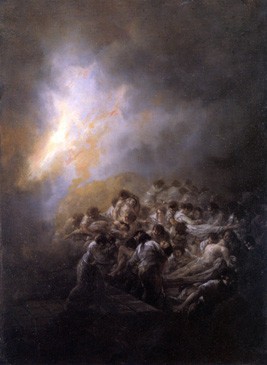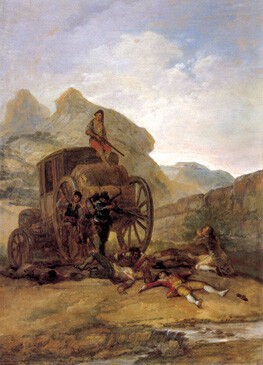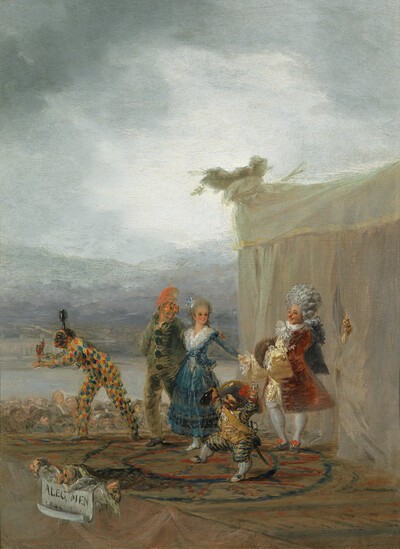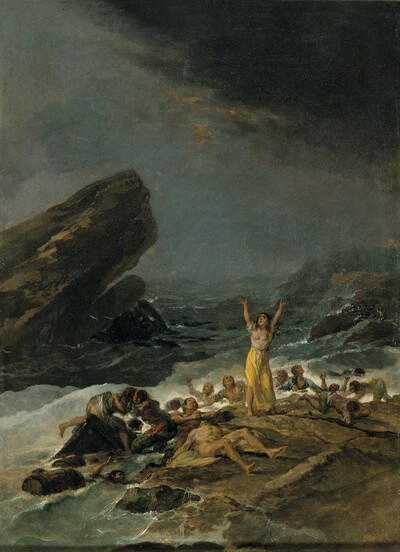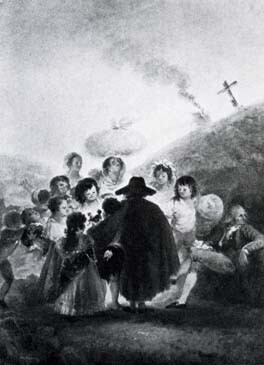- Cronología
- Ca. 1793
- Ubicación
- Abelló Collection, Madrid, Spain
- Dimensiones
- 43 x 32 cm
- Técnica y soporte
- Oil on tin
- Reconocimiento de la autoría de Goya
- Undisputed work
- Titular
- Abelló Collection
- Ficha: realización/revisión
- 29 Apr 2010 / 22 Nov 2022
- Otros títulos:
-
Fire at Night (Fuego en la noche)
Before arriving at its current location, this painting has belonged to a number of different owners, including: Ángela Sulpice y Chopinot, Madrid; the Count of Adanero, Madrid; the Marquis of Castro Serna, Madrid; the Duke of Campo Giro; and José Luis Várez, San Sebastián.
This scene, painted whilst Goya was staying at the home of his friend Sebastián Martínez in Cádiz, is set in an indeterminate space in which a crowd of people is fleeing from a fire, which can just be made out in the background. It takes place at night and the people are dressed in white nightclothes, caught unawares by the fire as they slept. Many of them have already perished, whilst others run away in fear or are carried along by other survivors.
The predominantly dark painting features two lighter-coloured areas. One of these, intensely bright and flecked by yellow brushstrokes, is the light given off by the fire, whilst the other, somewhat more tenuous and dynamic, is formed by the mass of human beings dressed in white, escaping from the flames. Just as he did in The Shipwreck, in the foreground Goya has placed a half-naked body, its torso slightly arched, extended out across the ground so as to grab our attention. This figure could have been inspired by the posture adopted by Abel as he is being brutally murdered in the drawing that the artist made on page 31a of his Italian Sketchbook.
In this painting, Goya has done away with any spatial reference that might help the viewer to orientate themselves. This vagueness heightens the sensation of helplessness and produces an atmosphere of terror and distress. As such, it seems unlikely that Goya was referring to any specific event and it is reasonable to assume that this image, verging on the abstract, is an allusion to tragedies and disasters in general.
This work is directly related to the scene of a fire which Goya painted on and which is now in the National Fine Arts Museum in Buenos Aires. That later work is even more abstract and essential in its references.
See Bulls in the Meadow.
-
GoyaKoninklijk Kabinet van Schilderijen MauritshuisThe Hauge1970organized by Ministerio de Estado y Asuntos Culturales and Réunion des Musées Nationaux, July 4th to September 13th 1970. Exhibited also at the Musée de l’Orangerie des Tuileries, Paris, October 25th to December 7th 1970, consultant editors Jeannine Baticle and A. B. de Vriescat. 14
-
Goya nelle collezioni private di SpagneVilla FavoritaLugano1986consultant editor Marta Medina. From June 15th to October 15th 1986cat. 18
-
Goya. El Capricho y la Invención. Cuadros de gabinete, bocetos y miniaturasMuseo Nacional del PradoMadrid1993from November 18th 1993 to February 15th 1994. Exhibited also at the Royal Academy of Arts, London, March 18th to June 12th 1994 and The Art Institute of Chicago, Chicago, July 16th to October 16th 1994, consultant editors Manuela B. Mena Marqués and Juliet Wilson-Bareaucat. 39
-
Goya's RealismStatens Museum for KunstCopenhagen2000from February 11th to May 7th 2000pp. 184-185, cat. 46
-
Goya: Prophet der ModerneAlte NationalgalerieBerlin2005from July 13th to October 3th 2005. Exhibitied also at the Kunsthistorischemuseum, Vienna, October 18th 2005 to January 8th 2006, consultant editor Manuela B. Mena Marquéscat. 30
-
Goya en tiempos de guerraMuseo Nacional del PradoMadrid2008consultant editor Manuela B. Mena Marqués, from April 14th to July 13th 2008cat. 2
-
Goya: Order and disorderMuseum of Fine ArtsBoston2014cat. 225
-
GoyaBasle2021p. 146
-
Vie et ouvre de Francisco de GoyaParísOffice du livre1970p. 169, cat. 329
-
GoyaParísMinistère d’Etat-Affaires culturelles y Réunion des Musées Nationaux1970vol. I, p. 293, cat. 345
-
L’opera pittorica completa di GoyaMilanRizzoli1974p. 169, cat. 329
-
Francisco de Goya, 4 vols.ZaragozaCaja de Ahorros de Zaragoza, Aragón y Rioja1980-1982vol. II, p. 70
-
Goya. Arte e condizione umanaNaplesLiguori editore1990p. 75, il. 63
-
Goya. El capricho y la invención. Cuadros de gabinete, bocetos y miniaturasMadridMuseo del Prado1993pp. 200, 201, 202, 203 y 205 (il.), cat.
-
Goya e Italia, 2 vols.ZaragozaFundación Goya en Aragón y Turner2008vol. II, p. 155, il. 6
